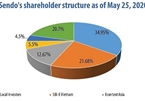 |
| Even though Lazada was first in Vietnam to move ahead, Shopee and others are gaining more traction Photo: Le Toan |
Nguyen Hung, a 30-year-old office worker in Ho Chi Minh City, had never shopped online until the coronavirus crisis. As many retail vendors closed to curb the spread of the virus, Hung began to visit e-commerce websites to buy items ranging from home décor products to shoes.
The young man was one of many first-time online shoppers during Vietnam’s social distancing.
The pandemic was a wake-up call for retailers to beef up their e-commerce divisions.
Craig Schmeizer, chairman of mattress retailer Vua Nem, said that much of the world in the span of just two or three months has come to operate largely online. People have adjusted in record time to new ways of communicating, sharing information, and maintaining connection. This change has relied on digital channels like never before.
“We have all developed increased engagement on digital communications and with this, we are witnessing a commerce shift. We are all becoming more reliant on e-commerce and we are growing more comfortable with buying online. This change is not merely situational – it is becoming structural and will define a much higher distribution of purchasing by consumers through the e-commerce channel,” Schmeizer said.
The e-commerce concept was largely unknown in Vietnam before Lazada entered the market in 2012. Since then, the segment has gained remarkable momentum, now featuring four key players Shopee, Lazada, Tiki, and Sendo battling it out in a ruthless war of attrition.
According to research firm Statista, revenue in the Vietnamese e-commerce market will amount to US$5.77 billion in 2020, with a compound annual growth rate of 9% in the 2020-2024 period, resulting in a market volume of US$8.16 billion by 2024.
The shift to e-commerce has been a challenge for traditional brick-and-mortar stores as more consumers are shopping online instead of in person.
The Malaysian department store operator Parkson, which entered the market in 2005 and eventually opened nine properties, has been closing down malls since 2015. Currently on its website, Parkson said it is now operating seven commercial centres nationwide.
Casino, the European grocer, made its first foray into Vietnam in 2003 via Big C. It was followed by the Republic of Korea's Lotte, which entered in 2007. Since then, Casino has divested, and other foreign players have slowed down store expansions.
Auchan, another European grocer, entered Vietnam in 2015 but exited only four years later. Meanwhile, Lotte has not closed a year with profit in Vietnam.
Since its inception, VinCommerce has been on an expansion drive with both acquisitions and new store openings. As of April 2019, VinCommerce took the lead in the number of stores, with over 100 supermarkets and approximately 1,900 minimarkets, followed by Bach Hoa Xanh and Saigon Co.op with around 500 and 460 outlets, respectively.
Other retailers such as Phu Nhuan Jewellery (PNJ), Mobile World, and FPT Retail have also been expanding their chains at a breakneck pace. PNJ has increased the number of its stores from 219 in 2016 to 349 in 2020.
Similarly, Mobile World grew the number of its stores from 1,247 to 3,197 during the same period. Meanwhile, FPT Retail’s store count grew from 473 to 686 between 2017 and 2020.
Retailers have been mainly opening new stores to achieve economies of scale and create a driving force for future development. The rate of new store openings was an early indicator of profit growth and thus business success. However, this strategy has not served retailers particularly well for years.
Physical stores going out of business are drawing up a long-term trend. As the retail industry has been turning digital for at least eight years now, these foreign investors arrived without realising that the times are changing and that the influence of technology will make Vietnam a different playground than their home markets 10-20 years ago – and Parkson and others’ example shows those who are sluggish to change will not stay afloat for long.
Kicking this trend into a far higher gear, COVID-19 is ripping up the traditional retail playbook as it forces retailers to close brick-and-mortar outlets and embrace new trade channels.
Ralf Matthaes, managing director of market research firm Infocus Mekong, cited the firm’s COVID-19 tracker in May which surveyed over 30 sectors to show that online shopping saw the single largest growth with a 33% gain in present/future usage.
It is followed by a 28% increase in spending on utilities, as consumers are staying at home and shopping online, driving up the cost of utilities such as electricity and water.
Meanwhile, going out for entertainment and dining out took the largest hit, with a drop of 61%, indicating reduced spending in June and potentially onwards.
Online payments/e-wallet, saw the third biggest gain with 10%, further solidifying the government’s cashless initiatives and potentially alleviating the continuous losses of e-commerce sites which have been struggling with costs related to cash on delivery payments.
“Inversely, all other retail channels, save for convenience stores and super/hypermarkets whose growth was flat, saw a significant drop, with wet markets usage dropping by 17% now and in the foreseeable future,” Matthaes said.
Many major retail chains have fast-tracked the adoption of omnichannel retail following the COVID-19 crisis. It means providing customers with unique journeys that span both the offline and online worlds. Big C has launched the GO! & Big C App for online grocery shopping during the nationwide social distancing.
Big C also saw the number of orders placed via telephone in March double against the previous month, while the value of orders also rose by 80-120%.
Similarly, longstanding Vietnamese supermarket operator Saigon Co.op has implemented the Scan & Go virtual store, as well as joining hands with MoMo e-wallet to provide cashless payment as part of its omnichannel strategy.
Julien Brun, managing partner of CEL Consulting, told VIR that omnichannel is not a new concept and the emergence of e-commerce and modern retailers over the past five years has invited brands to consider these emerging channels. Yet, for fast-moving consumer goods, the traditional trade (mom and pop stores, wet markets) is still by far the predominant channel. E-commerce and modern trade together represent only 20-35% of total sales only.
Particularly post-COVID-19, companies have no choice but to reformulate their expansion strategies along three main channels (traditional trade, modern trade, and e-commerce) and the synergies between them, according to Brun. VIR

Dual lightning strikes to turn Vietnam’s e-commerce equilibrium upside down
The e-commerce market is looking at two high-calibre developments with the merger of Tiki and Sendo and the entry of heavyweight competitor Facebook.

E-commerce a positive for VN retail sector
Despite the impact of the COVID-19 pandemic, the retail market in Vietnam in the first quarter of this year still recorded positive results from e-commerce, online shopping and delivery services.